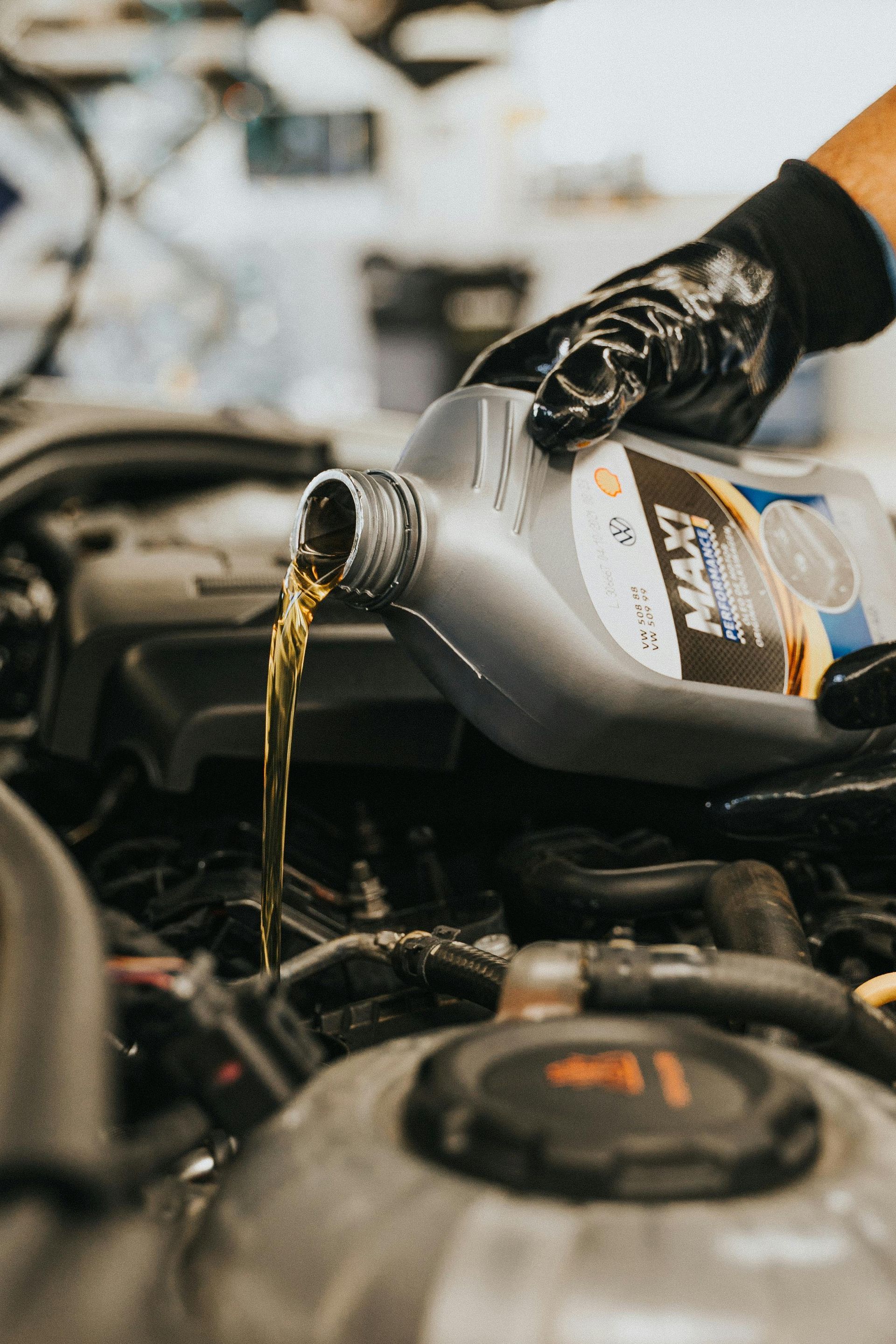Should I Ignore My Check Engine Light?
Faisal Momin • December 18, 2024
Should I Ignore My Check Engine Light?

Ignoring your check engine light is not a good idea for several reasons, as it can lead to a range of negative consequences for your vehicle's performance, safety, and your wallet.
Here are some key points to consider:
Immediate and Long-Term Consequences
Ignoring the check engine light can result in both immediate and long-term problems. Even if your car seems to be running fine, the underlying issue can escalate over time, leading to more severe and costly repairs. For example, a faulty oxygen sensor can cause your engine to run inefficiently, which may eventually damage your catalytic converter, a repair that could cost thousands of dollars.
Safety Risks
The check engine light often indicates issues that can compromise the safety of your vehicle. Ignoring these warnings can lead to accidents or system failures while driving. For instance, engine misfires or overheating can pose significant safety hazards.
Reduced Fuel Efficiency and Performance
Ignoring the check engine light can lead to reduced fuel efficiency and decreased performance. Issues like a malfunctioning oxygen sensor or a faulty catalytic converter can cause your engine to run less efficiently, increasing fuel consumption and potentially leading to other system failures.
Emissions and Registration Issues
In many states, a functioning emissions control system is required to pass a smog test. If the check engine light is on due to emissions-related issues (such as a faulty catalytic converter or evaporative emissions system), your vehicle may fail the smog test, and you won't be able to register it until the problem is resolved.
Hidden Issues
The check engine light can mask other underlying issues. One sensor or system failure can cause another to fail, and these secondary issues might not be immediately apparent. A thorough diagnosis by a mechanic is necessary to address all related problems.
Common Reasons for the Check Engine Light
Some common reasons for the check engine light to come on include:
- A loose or missing gas cap
- A bad oxygen sensor
- Emission problems
- Faulty spark plugs, spark plug wires, and ignition coils
- Catalytic converter issues
- Internal engine problems
- Worn-out timing belt
- Loose or damaged exhaust pipe
- Low fluid levels
Diagnostic Steps
If your check engine light comes on, here are some steps you can take:
- Use an OBD-II scan tool to read the diagnostic trouble codes.
- Check your owner’s manual to understand the codes.
- Inspect your vehicle for any obvious signs of damage or wear and tear.
- It is best advised to consult with a automotive repair specialist to pinpoint the specific issue and advise the corrective repair
In summary, ignoring your check engine light is not advisable. It is crucial to take the warning seriously, diagnose the issue promptly, and address any problems to ensure your vehicle's safety, performance, and to avoid costly repairs in the long run.
Need reliable brake service in Houston? Carmotive offers expert brake care. Ensure safety & performance. Visit us today!
Discover expert A/C & heating services at Carmotive in Houston, TX. Keep your car comfortable in any weather. Schedule an online appointment now!

In Houston, heavy downpours can hit with little warning—especially during the rainy season. Your windshield wipers are your first line of defense for maintaining visibility, and neglecting them can make driving dangerous. Knowing when to replace your wipers can help you stay safe and avoid unexpected issues on the road. 1. Streaking or Smearing If your wipers leave streaks, smudges, or miss spots on your windshield, it’s a clear sign the rubber has worn down. This can drastically reduce visibility during a storm. 2. Chattering or Skipping A wiper blade that jumps or makes a chattering noise means it’s not making proper contact with the glass. This often happens when the blade is hardened or damaged from Houston’s heat between rainstorms. 3. Visible Cracks or Tears Inspect your blades regularly. If you notice cracks, fraying edges, or pieces of rubber peeling off, it’s time for a replacement before the next big rain hits. Pro Tip for Houston Drivers: Because of our extreme heat and sudden downpours, wiper blades here often need replacing every 6–12 months—sometimes more frequently if your car is parked outside. Regular checks will ensure you’re always ready for whatever the Houston skies throw your way.

Your alternator is one of the hardest-working parts of your car’s electrical system. It keeps your battery charged and powers everything from your headlights to your air conditioning while you’re on the road. If it fails, your vehicle can quickly lose power and leave you stranded—especially in Houston’s busy traffic. Luckily, there are a few early warning signs you can look out for: 1. Dimming or Flickering Lights If your headlights, dashboard lights, or interior lights are dimming or flickering, it could mean your alternator isn’t producing enough power. 2. Warning Light on the Dashboard Most cars have a warning light (often shaped like a battery or labeled “ALT” or “GEN”) that comes on when there’s an issue with the alternator. Don’t ignore it. 3. Slow or Dead Battery A failing alternator won’t charge the battery properly, leading to a weak or dead battery even if the battery itself is new. 4. Strange Noises Squealing or grinding noises under the hood could indicate a problem with the alternator belt or the alternator bearings. 5. Electrical Issues Power windows, power seats, the radio, or other electrical accessories may start acting sluggish or stop working altogether. 6. Difficulty Starting the Car If your car struggles to start—or won’t start at all—the alternator could be failing to deliver the charge needed to power the starter. Don’t Wait Until It’s Too Late Ignoring alternator issues can lead to a complete breakdown, which is never convenient (especially in Houston traffic or summer heat). If you notice any of these signs, it’s best to have your charging system tested right away. At Carmotive, we can quickly diagnose alternator issues and get you back on the road with confidence. Don’t risk getting stranded—schedule a charging system check today.
Discover unparalleled diagnostics & auto repair in Houston. Carmotive offers expert care for your vehicle's needs. Schedule a visit today!

Your car’s suspension system does more than just keep your ride smooth—it also helps maintain control, stability, and safety on the road. And with Houston’s combination of potholes, heat, and stop-and-go traffic, your suspension takes a beating over time. Knowing when your suspension needs attention can save you from bigger (and more expensive) repairs down the road. Here are some top signs it’s time to get your suspension checked: 1. You Feel Every Bump If every little bump or crack in the road sends a jolt through your seat, your shocks or struts may be worn out. The suspension system is designed to absorb impact, so when it stops doing that, it’s a clear red flag. 2. The Car Pulls or Drifts When Turning When your suspension is failing, it can affect how your vehicle handles turns. If your car feels like it’s drifting or leaning too much around corners, it could mean your shocks aren't keeping the car stable. 3. Uneven Tire Wear A healthy suspension system keeps all four tires evenly planted. If you notice uneven wear on your tires—especially if one side is balding faster—it could be due to misaligned or worn suspension components. 4. Your Car “Nose Dives” When Braking Does the front of your car dip dramatically when you hit the brakes? That’s a common sign your shocks or struts are worn and can no longer manage the vehicle’s weight properly under pressure. 5. Fluid Leaks Near the Wheels Leaking shocks or struts often leave visible oily spots near the wheel wells. If you spot any unusual fluid around your tires, it’s time for a closer inspection. 6. Bouncing After a Bump Try the bounce test: press down on the hood of your parked car and release. If the car continues bouncing more than once or twice, your shocks may be on their way out. Don’t Let Houston Roads Wear You Down From Westheimer potholes to I-10 speed bumps, Houston’s roads can be rough. Keeping your suspension in good shape isn’t just about comfort—it’s about safety and control. At Carmotive, we offer suspension inspections and repairs to help keep your ride smooth and secure. If you’re noticing any of these signs, let our technicians take a look and get you back on track. Drive safe, drive smooth—book your suspension check today.

Living and driving in Houston means navigating through daily traffic jams, endless construction zones, and sudden stops on busy highways. All of that puts extra stress on one of the most important parts of your car: your brake pads. So how often should you replace them? The answer depends on a few things—but if you’re in Houston, chances are you’ll need them sooner than drivers in more relaxed driving environments. The General Rule Most brake pads should be replaced every 30,000 to 70,000 miles, but that’s a wide range. The actual lifespan depends on your driving habits, vehicle type, and local conditions. In cities like Houston, where daily commutes involve frequent braking and stop-and-go traffic, you may find yourself needing new pads closer to the 30,000–40,000 mile mark. Signs It’s Time to Replace Your Brake Pads You don’t always have to rely on mileage alone. Look (or listen) for these common signs that your brake pads are wearing down: Squeaking or squealing noises Grinding sounds when braking Longer stopping distances A vibrating brake pedal Warning light on your dashboard (in some vehicles) If you notice any of these symptoms while driving through Houston, it’s best to get your brakes checked right away. Why Houston Driving Wears Brakes Faster Heavy traffic: Constant braking in stop-and-go conditions leads to faster brake pad wear. High temperatures: Houston heat can increase brake system temperature, affecting pad longevity. City driving: Compared to highway driving, city routes require more frequent stops and turns. Don’t Wait Until It’s Dangerous Worn brake pads can seriously impact your ability to stop quickly—especially in wet weather or emergency situations. And if ignored long enough, they can damage your rotors, leading to more expensive repairs. Stay Safe with Carmotive At Carmotive, we recommend regular brake inspections, especially for Houston drivers dealing with daily traffic. Whether it’s time to replace your pads or you just want peace of mind, we’ve got you covered. Stop by today for a brake check and keep your commute safe, smooth, and worry-free.

Houston heatwaves don’t just leave you feeling drained—they can do the same to your vehicle. When temperatures soar, your car’s fluids work overtime to keep things cool, lubricated, and running smoothly. Neglecting them in extreme heat can lead to breakdowns, costly repairs, or even engine damage. Here are the top 5 fluids Houston drivers should check when the heat hits hard: 1. Engine Coolant (Antifreeze) Coolant is your car’s first line of defense against overheating. In the Houston heat, low or old coolant can lead to engine damage fast. What to do: Check the coolant level in the reservoir and make sure the fluid is clean and brightly colored. Top off or flush it if needed. 2. Motor Oil Engine oil lubricates your engine’s moving parts and helps keep temperatures in check. High heat can thin the oil or speed up its breakdown. What to do: Check oil levels and consistency—if it looks dark and dirty, it’s time for a change. Stick to your regular oil change schedule or move it up during peak summer. 3. Transmission Fluid Your transmission fluid keeps the gears shifting smoothly and prevents overheating. Houston traffic, especially in the summer, can stress this system out. What to do: Look for bright red, clean fluid on the dipstick. If it’s brown, smells burnt, or is low, have it inspected or flushed. 4. Brake Fluid Brake fluid absorbs heat and ensures your brakes respond quickly. But in extreme heat, moisture contamination or old fluid can reduce braking power. What to do: Have your brake fluid tested—if it’s dark or hasn’t been flushed in a few years, it’s worth replacing for safety. 5. Power Steering Fluid This fluid helps you steer smoothly and easily. When it gets too hot or low, steering can become stiff or noisy. What to do: Check your power steering fluid levels and condition. If it looks dark or smells burnt, it may be time for a service. Stay Cool, Houston Don’t let a heatwave sideline your ride. Keeping up with your fluid checks is one of the easiest ways to prevent bigger issues during a Houston summer. Need help? Stop by Carmotive—we’ll inspect your fluids and make sure your car is heatwave-ready.
Discover top-notch auto A/C & heating services at Carmotive in Houston, TX. Ensure comfort all year round. Schedule an online appointment now!

If you’ve been driving around Houston for a while, you already know the roads can be rough—potholes, uneven surfaces, stop-and-go traffic, and sweltering heat all take a toll on your tires. One simple way to protect your investment and improve your driving experience? Tire rotation. What Is Tire Rotation? Tire rotation means regularly changing the position of your tires—typically moving the front tires to the rear and vice versa. This helps ensure that all four tires wear evenly over time. Why It’s Especially Important in Houston Uneven Road Conditions Houston streets can be unpredictable. Between construction zones and pothole-ridden areas, tires often wear unevenly. Rotating them helps balance that wear and prevents premature tire replacement. Heat and Traffic Stress The intense Houston heat and daily stop-and-go traffic put pressure on your front tires in particular. Without regular rotation, you might find yourself replacing those front tires much sooner than the rear ones. Improved Handling and Safety Even tire wear leads to better traction, more balanced handling, and a smoother ride—especially important during Houston’s sudden downpours or emergency stops on I-10. How Often Should You Rotate? A good rule of thumb is every 5,000 to 7,500 miles, or roughly every other oil change. Always check your owner’s manual for specific intervals. At Carmotive, we can rotate your tires during routine maintenance visits to keep your schedule simple. Extend the Life of Your Tires Tires aren’t cheap—so why let them wear out faster than they should? With regular rotations, Houston drivers can enjoy better performance, improved fuel efficiency, and maximum tire life. Need a tire rotation? Come by Carmotive and let us help you stay safe on the road, wherever Houston takes you.




